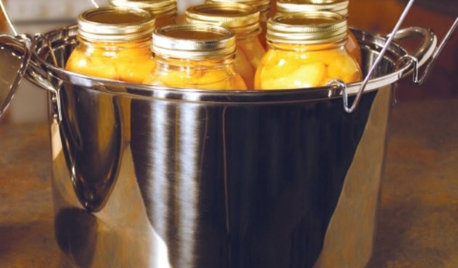Canning tomatoes - no lemon juice on hand
ediej1209 AL Zn 7
15 years ago
Related Stories

PRODUCT PICKSGuest Picks: Canning, Preserving, Steaming, Dehydrating
20 products to help make fall produce last through the season and beyond
Full Story
LIFEKitchen Traditions: Tomato Season Meets a Family Legacy
Somewhere a Sicilian great-great-grandmother is smiling at a bowl of American-made sauce
Full Story
SHOP HOUZZHouzz Products: Save a Taste of Summer
Can't bear to part with the flavors of summer peaches, berries and tomatoes? Then jam on it!
Full Story
LIFESlow Living 101: Tips for Turning Off the Chaos
It may feel as though you're too busy to slow down and enjoy life. But even little changes can have a big effect
Full Story
GARDENING AND LANDSCAPINGWorld of Design: 10 Home Gardeners Show Us Their Sweet Summer Harvests
From New York to Tokyo, these gardeners have turned their yards, terraces and rooftops into places of bounty
Full Story
KITCHEN COUNTERTOPS7 Low-Maintenance Countertops for Your Dream Kitchen
Fingerprints, stains, resealing requirements ... who needs ’em? These countertop materials look great with little effort
Full Story
DIY PROJECTS17 Ways to Decorate With Everyday Things
Characters on the new Netflix series 'Orange Is the New Black' make the most of what they have. Here's how you can too
Full Story
PRODUCT PICKSGuest Picks: Be Your Own Artisanal Chef
You may never settle for prepared foods again with these cooking tools, gadgets and storage pieces
Full Story
TRADITIONAL STYLEDecorating With Antiques: Silver’s Legacy
Learn how to tell sterling from plate, ways to display pieces and why silver is so darn special to begin with
Full Story
KITCHEN DESIGNCreate Your Own Checklist for a Well-Stocked Kitchen
Personalize the kitchen with your own must-haves from our list of top cooking tools, small appliances, pots, pans and more
Full Story

readinglady
ksrogers
Related Professionals
Lake Oswego Landscape Architects & Landscape Designers · Bristol Landscape Contractors · Chelmsford Landscape Contractors · Florham Park Landscape Contractors · Muttontown Landscape Contractors · Pleasant Hill Landscape Contractors · Ridgewood Landscape Contractors · Wilton Landscape Contractors · Ferguson Landscape Contractors · Atlanta Roofing & Gutters · Maplewood Roofing & Gutters · Westchester Roofing & Gutters · Chattanooga Driveway Installation & Maintenance · Daphne Driveway Installation & Maintenance · Riverside Driveway Installation & Maintenancedigdirt2
ediej1209 AL Zn 7Original Author
readinglady
digdirt2
ksrogers
digdirt2
melva02
readinglady
ksrogers
digdirt2
Debby Powell Jennex
digdirt2